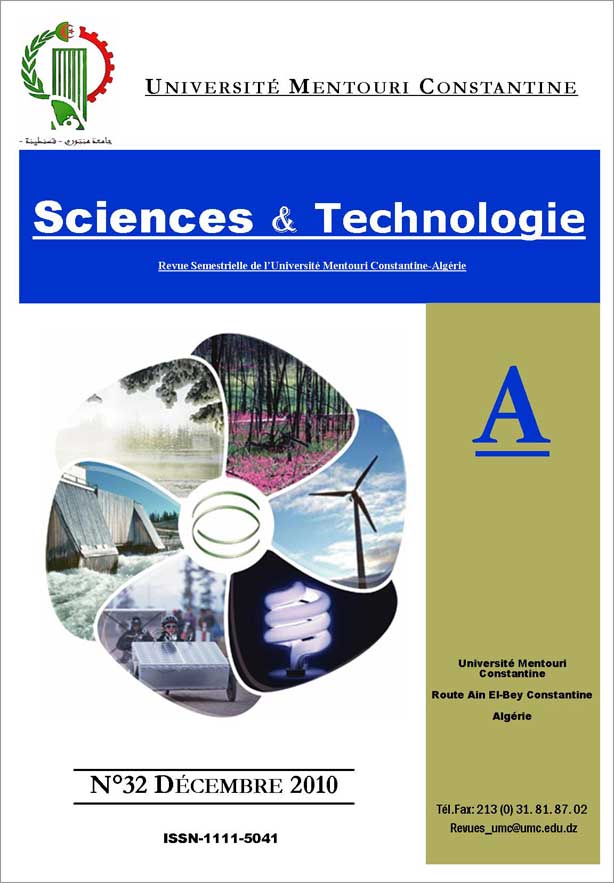CONJUGATE HEAT TRANSFER WITH VARIABLE FLUID PROPERTIES IN A HORIZONTAL ANNULUS
Keywords:
Laminar Mixed Convection, Concentric Pipes, Conjugate Heat Transfer, Numerical simulationAbstract
In the present work, we numerically study the three-dimensional conjugate heat transfer in an annular space between two horizontal concentric cylinders; the outer cylinder is subjected to an internal energy generated by Joule effect through its thickness while the inner is adiabatic. The thermal convection in the fluid domain is conjugated to the thermal conduction in the solid. The physical properties of the fluid are thermal dependant. The heat losses from the external outside pipe surface to the surrounding ambient are considered. The model equations of continuity, momenta and energy are numerically solved by a finite volume method with a second order spatiotemporal discretization. The obtained results show the three dimensional aspect of the thermal and dynamical fields with considerable variations of the viscosity and moderate variations of the fluid thermal conductivity. As expected, the mixed convection Nusselt number becomes more superior to that of the forced convection when the Grashof number is increased. At the solid-fluid interface, the results show clearly the azimuthal and axial variations of the local heat flux and the local Nusselt numbers. Following these results, we have tried modelling the average Nusselt number as a function of Richardson number. With the parameters used, the heat transfer is quantified by the correlation: Nua = 12.8678 Ri (pui 01426)Downloads
References
Islam. N, U. N. Gaitonde. U. and Sharma. G. K, “Mixed convection heat transfer in the entrance region of horizontal annuli”, Int. J. Heat Mass Transfer, vol. 44, (2001), pp. 2107-2120.
Kotake. S, Hattori. N, “Combined forced and free convection heat transfer for fully-developed laminar flow in horizontal annuli”, Int. J. Heat Mass Transfer, vol. 28, (1985), pp. 2113-2120.
Kumar. R, “Study of natural convection in horizontal annuli”, Int. J. Heat Mass Transfer, vol. 31, (1988), pp. 1137-1148.
Chung. S. Y, Rhee. G. H, and Sung. H. J, “Direct Numerical Simulation of Concentric Annular Pipe Flow”
Part I: Flow Field, Int. J. Heat Fluid Flow, vol. 23, (2002), pp. 426-440.
NOUAR. C, “Numerical solution for laminar mixed convection in a horizontal annular duct: temperature-dependent viscosity effect”, Int. J. Numer. Meth. Fluids Vol. 29, (1999), pp. 849–864.
Habib. M. A, Negm. A. A, “Laminar mixed convection in horizontal concentric annuli with non-uniform circumferential heating”, Int. J. Heat Fluid Flow, Vol. 37, (2001), pp. 427-435.
Mohammed H. A, Campo A and Saidur. R, “Experimental study of forced and free convective heat transfer in the thermal entry region of horizontal concentric annuli”, International Communications in Heat and Mass Transfer, Vol. 37, (2010), pp. 739–747.
Churchill. S. W, Chu. H. S, “Correlating Equation for Laminar and Turbulent Free Convection from a Horizontal Cylinder”, International Journal of Heat and Mass Transfer, Vol 18, (1975), pp. 1049-1053
Patankar. S. V, Numerical Heat Transfer and Fluid Flow, McGraw-Hill, New-York: (1980).
Carlo. N, Guidice. S. D, “Finite element analysis of laminar mixed convection in the entrance region of horizontal annular ducts”, Numer. Heat Transfer, Part A, 29, (1996), pp 313-330.







